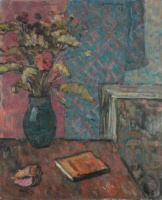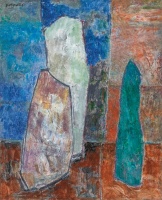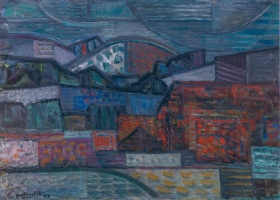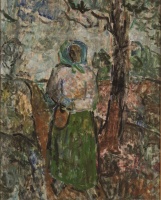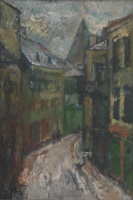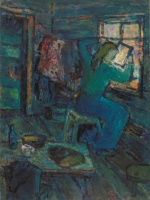
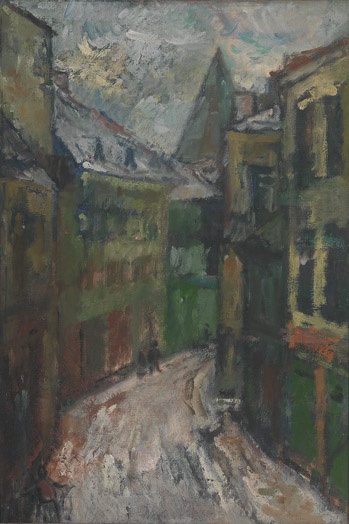

Vokiečių Street in Vilnius
| Author: |
Algirdas Petrulis (1915–2010)  |
| Created: | 1944 |
| Material: | canvas |
| Technique: | oil |
| Dimensions: | 62.50 × 42.50 cm |
| Signature: | unsigned |
The famous Lithuanian painter Algirdas Petrulis (1915–2010) studied at Kaunas School of Art under Justinas Vienožinskis. During the German occupation he worked at the Vilnius Art Museum, and in 1944 he graduated as an external student from the Institute of Art in Vilnius. Early in the same year, he painted the picture Vokiečių Street in Vilnius, portraying one of the most important Jewish streets in the Old Town. The picture shows the view from the window of the museum where he worked, and reflects the circumstances of the period and the oppressive wartime mood: the gloomy winter dusk, the narrow side street, the boarded-up doors and dark windows, a few lonely figures walking through the slushy snow, and the bell tower of the Evangelical Lutheran Church in the distance. Petrulis achieved a rich range in dark blues and greens of many shades, and the brushstrokes create a pulsating surface for the picture. Its value is not only artistic: in the summer of 1944, the Soviet army pushed the Germans out of the city, and bombed Vokiečių Street, reducing the right side of the street to ruins. After the war, the ruins were cleared and the street was widened, and therefore it completely lost its former appearance as it appears in Petrulis’ picture.
Text author Laima Laučkaitė
Vilnius is often seen through a window in wartime works. When the Nazis banned painting in the streets, artists found a way out by capturing views of the city from safe private spaces, such as their or their friends’ homes, offices or studios. One of the hubs of artistic life in Vilnius at that time was the Vilnius Art Museum in the Town Hall, directed by Adolfas Valeška (1905–1994). Before moving to the regained capital in 1939, Valeška had been a collector of folk art and head of the Museum of Church Art in Kaunas. In his painting Vilnius through the museum window, we can see not only a view of the city with Town Hall Square, but also Lithuanian cultural symbols that the artist considered relevant: a sculpture of the Mother of God carved by a folk craftsman, and some fabric with folk patterns.
Vytautas Mackevičius (1911–1991) also painted the city through a window, but for rather different reasons. In 1940 and 1941, he had worked in Soviet Lithuania as an inspector for the Board of Art Affairs, so during the Nazi occupation he tried to keep a low profile, and painted Town Hall Square from Valeška’s studio, which was next to the museum.
Algirdas Petrulis (1915–2010) was employed as a curator at the museum run by Valeška. The view Vokiečių Street in Vilnius that he painted through the museum window, capturing part of the Old Town that was later destroyed during the Soviet occupation, is now part of history.
Text authors Dovilė Barcytė and Ieva Burbaitė
Source: Law firm Valiunas Ellex art album VILNIUS. TOPOPHILIA I (2014). Compiler and author Laima Laučkaitė, KAUNAS–VILNIUS / 1918–1945 (2021). Compilers and text authors Dovilė Barcytė and Ieva BurbaitėExpositions: “Vilnius. Topophilia. Views of Vilnius from the collection of the law firm Ellex Valiunas”, 5 October – 26 November 2017, National Gallery of Art, Vilnius. Curator Laima Laučkaitė; "A Glance at the History of Lithuanian Art from Užupis", 30 August 2018 – 1 June 2019, Lithuanian Art Centre TARTLE (Užupio St. 40, Vilnius). Curator Giedrė Jankevičiūtė.
© LATGA, Vilnius 2024







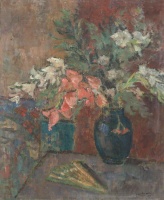
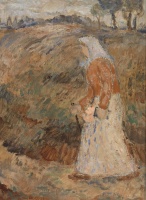
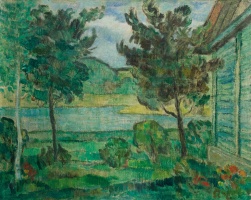
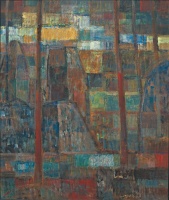
.jpg)
